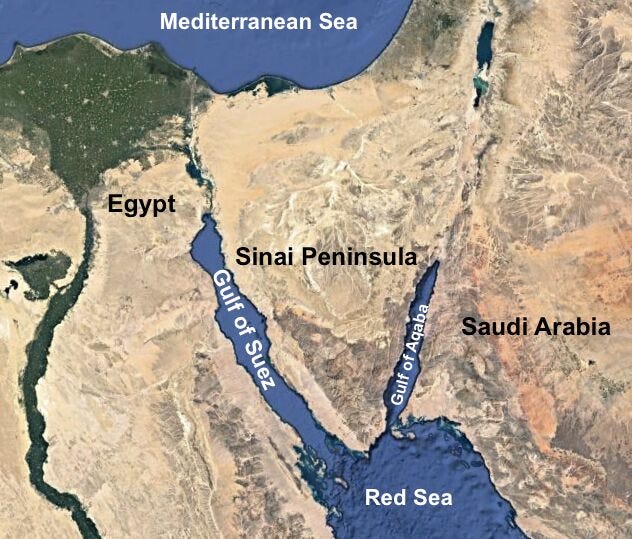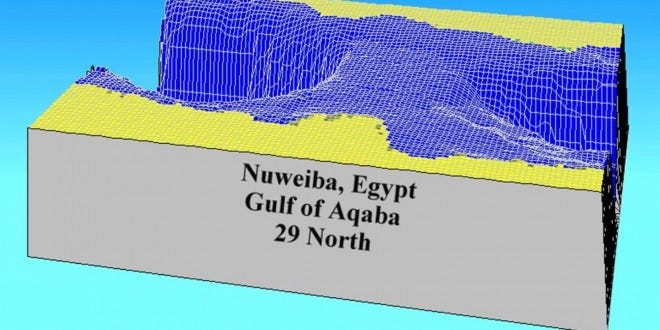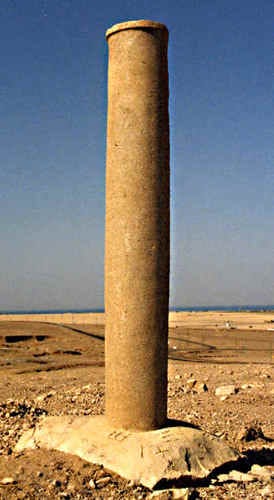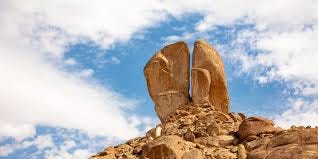Last week, I showed the strong evidence that the Hebrews spent 400 years in Egypt and then left suddenly. This week, I spent considerable time researching the journey itself.
It begins with crossing the Red Sea. There are multiple proposed sites for this miracle. Some people believe that they crossed a land bridge in the marshy area where the Suez Canallies today. But that location isn’t impressive enough to make a story…and it doesn’t line up with very specific details of the Bible story. Others assume that the crossing took place farther south, across the Gulf of Suez, but again, the Bible indicates a more remote and mountainous location. The best match is found along a branch of the Red Sea at the Gulf of Aqaba, based on the detailed description of Moses and the Hebrews twisting and turning to the east, away from the Philistines and “closed in” by a canyon.
A canyon called Wadi Watir leads through the mountains of the Sinai peninsula down to a beach at a town called Nuweiba. At Nuweiba, there’s a huge alluvial fan of deposits from the canyon, which seems gigantic when we consider the tiny amount of rainfall and water flow down the canyon.
The Gulf of Aqaba sits along the fault line separating the African tectonic plate from the Asian plate. These two plates are moving away from each other, causing the Gulf to be extremely deep, and also creating depressions such as the Dead Sea, which is below sea level. At Nuweiba, the depth in the center of the Red Sea is about 800 meters, but on the north and south sides of this “land bridge” the depth is more than 1500 meters.
In fact, the alluvial fan extends several miles out into the Red Sea, and today it fills up the trench about halfway.
Weather could be a factor here. Starting about 14,500 years ago, Egypt experienced a period of much heavier rainfall. Cave paintings show hippos in the Sahara during that time. Scientists estimate that the level of rainfall started to change about 5,000 years ago, so there was a period of 10,000 years or more with elevated water flow down the Wadi Watir. It’s possible that the Wadi could have deposited enough sand to raise the “land bridge” to roughly sea level across the entire Gulf.
Based on the known changes in climate, it’s plausible that Moses and more than a million Hebrews could have crossed a land bridge that was much shallower than it is today. The tidal currents are mild in this part of the world (about a three-foot tide), but that’s enough to erode the sand by 800 meters over a period of 3,500 years. In fact, the wide and gentle slope of the sand floor across the Gulf indicates exactly that kind of tidal erosion, spreading the sand into the Gulf.
With the opening of Egypt and Saudi Arabia to tourism in the 20th century, many researchers have traveled there and looked for evidence of the crossing. Search on YouTube and you’ll find incredible videos. Let me address each piece of evidence here:
1. Marble columns were found at Nuweiba (Egypt) and on the opposite Saudi shore, marked with an inscription which appears to indicate that they were placed by King Solomon, about 400 years after the Exodus. This marble is found nowhere in this area, so the columns were presumably brought by boat, and possibly from Israel. Today, the Egyptian column has been placed next to a road and collects graffiti. It’s too eroded to read the inscriptions. The Saudi column has been removed by the government, so no solid confirmation is possible at this time.
2. Several videos show the existence of coral formations growing out of the sand at Nuweiba, and also near the shore on the Saudi side. These formations are unusual, with straight lines and circular wheel-shaped structure. They’re also unusual because this type of coral doesn’t grow on sand, and because metal detectors have shown the presence of metal at the “hub” and along the “axle” of the coral. These videos are suggestive of chariots and wheels, but it’s not a smoking gun.
3. One researcher presented images of a four-spoke wheel, plated in gold or a gold/silver alloy. This was exciting, as it would suggest the Pharaoh’s personal chariot, but after researching these images, I found two points:
a. Images of the ‘gold wheel’, supposedly found in over 100 feet of water, had ripplines lines of sunlight from the surface waves that indicated a much more shallow depth.
b. I spoke with the author of a book on the Exodus evidence, Dr. Glen Fritz, who had met the researcher who provided this photo. He indicated that, in his opinion, the photo was fabricated.
4. Along the sandy beach at Nuweiba, large areas of sand have been fused or melted together like glass, indicating a tremendous amount of heat. The area is far too large to be the result of a campfire or other human cause…especially considering that the melted sand appears in the videos to extend below the water line. This appears to be evidence of the “pillar of fire” that blocked Pharaoh from reaching the Hebrews during their crossing. Nobody has a scientific explanation for the pillar of fire mentioned in Exodus, and there’s no adequate explanation for the melted sand.
After Moses and the Hebrews crossed the water, they entered an uninhabited and inhospitable desert. The location of their desert journey is disputed. If they crossed at Suez, the desert of Sinai appears likely, and if they crossed at Nuweiba, the desert of Saudi Arabia is more likely.
The Saudi theory has some major points in its favor. First, from the Bible story we know that Moses spent time in ancient Midian before returning to Egypt and leading the Hebrews. Midian was located in present-day Saudi Arabia, and we know that they traded copper with the ancient Egyptians, so it’s very plausible for Moses to be exiled in Midian.
Secondly, a mountain called Jabal al-Lawz in Arabic (Mountain of Laws) is located near the territory of ancient Midian in northwest Saudi Arabia. As the name suggests, local Muslim tradition holds that this is the mountain where Moses received the ten commandments.
Third, the western side of Jabal al-Lawz includes a unique rock formation that matches another Bible story. When the Hebrews were thirsty and ready to give up, Moses struck a rock with his staff, splitting the rock and causing water to gush out. Watch the video in this link: The Split Rock of Horeb shows clear signs of water erosion that originates in this crazy monolithic rock at the top of a hill. Flash floods or glaciers would not explain it, because of the shape of the hill and the lack of erosion on other rocks nearby. Based on the erosion, it seems clear that the water came out of the ground, from the split rock itself. Multiple researchers have filmed and verified this, so I don’t believe this one was faked.
We know that the Hebrews emerged from the desert strong enough to conquer Canaan. The Bible refers to 600,000 men and history tells us that this number would be required to conquer a populated, fertile country during that period. The miraculous part is that—during their desert crossing—they transformed from refugees into a conquering army.
God put the Hebrew people through an ordeal in the desert. They left the Nile and hiked into the desert. Did they stay in the desert for 40 years? Did they really eat magical food (manna) from heaven? There’s no evidence for these details, but it’s clear that they were put through a grueling experience and it made them stronger. From the next 3,500 years of history, we can say that the Hebrews became the indestructible culture, winning impossible wars and re-emerging after every setback.









